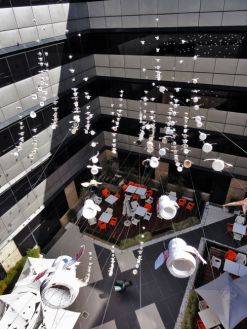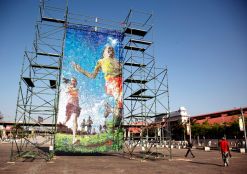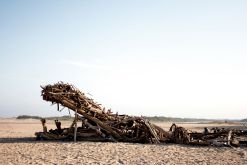
Waste gives Such artistic inspiration
When visual artists Hannelie Coetzee and Usha Seejarim decided to establish the Such Initiative in 2009, a participatory public art organisation, they had no idea that the project would generate so much interest. The idea came about in 2009 when Coetzee and Seejarim were sharing studio space. “We realised that if we work together we could […]

When visual artists Hannelie Coetzee and Usha Seejarim decided to establish the Such Initiative in 2009, a participatory public art organisation, they had no idea that the project would generate so much interest.

The idea came about in 2009 when Coetzee and Seejarim were sharing studio space. “We realised that if we work together we could achieve more and we were both keen to do community work. We also realised that we can take on bigger projects when we work together,” Coetzee says.
Since starting the initiative they have been awarded numerous high-profile commissions to create large-scale works of art using recyclable materials.
With each new work of art, waste material is transformed into something beautiful and their hope is that waste gains a currency, instead of being viewed as disposable items without value.

“Everything we do at Such is made from recyclables or material considered to be waste. We use whatever we see lying around,” she says.
Waste for a purpose
What inspires them the most is the participatory nature of their work and the involvement of communities in every project.
If people can experience the versatility of waste through the creation of art, it encourages discussion about recycling, has a unifying effect on communities and people start taking responsibility for their actions and the environment.
“We are motivated by a need to make meaningful contributions on a social, environmental and aesthetic level through public art,” she says.

There is no limit to the type of work they take on – they have created artworks across the country in the most unusual of locations.
For one of their projects, they spent a week on a beach to create a large hippo sculpture made from driftwood. The artwork, which was about 4m high and 30m long, was created in partnership with artists in St Lucia in KwaZulu-Natal.
All works of art are site-specific and created to tell a specific story in a place. “We find inspiration from the places where we work. We always visit the site before getting started to see how we can respond to the site in a visual way.”
Their willingness to salvage any waste item has led to the creation of thought-provoking and innovative art.
Such Initiative’s first corporate commission, awarded by Rand Merchant Bank (RMB), required them to make a swarm of bees from about 400 used paper cups from the company’s canteen.
RMB commissioned the Such Initiative to create the public artwork at their head office in Sandton earlier in 2011. The installation was to coincide with World Environment Day and the goal was to raise awareness about the need for recycling and waste separation at source.
The swarm of bees also made reference to other concepts such as black economic empowerment, or BEE; corporate culture; corporate workspace; collective thinking and collaboration.
Hundreds of handmade bees were suspended in the building’s atrium, using fishing gut. “What was wonderful about the site is that all the offices look onto the atrium and everyone could see the bees,” Coetzee says.
Although employees at first seemed reluctant to get involved with the project, many couldn’t contain their curiosity.
“As we were working people started asking questions and many people even brought their used coffee cups to us where we were making the bees.”
Although the installation was temporary, the artwork is to be included in a catalogue of all RMB art.
Coetzee said that the RMB commission achieved its purpose to encourage employees to think differently about their contribution to waste in the workplace.
Award-winning bottle top tapestry
The Such Initiative plastic bottle top mosaic project, commissioned by Arts Alive, an annual arts festival project of the City of Johannesburg, recently won an award.
The project claimed top honours in the Business and Arts South Africa Awards’ new Arts and Environment category. The bottle top project was sponsored by waste removal company Pikitup.
The mosaic project started during the 2010 Fifa World Cup in eight community centres in Johannesburg. Children were invited to participate and, in return, they learnt about art, recycling and eco-conscious living.
The tapestry, displayed on Mary Fitzgerald Square in Newtown in Johannesburg’s city centre, was made from 90 000 discarded plastic bottle tops. Its construction involved the eight community centres, 140 children, 30 disabled adults and 31 crafters.
Earlier this year the tapestry was exhibited at the National Arts Festival in Grahamstown.
Coetzee says the 14m-high tapestry was an ambitious project. All the bottle tops had to be woven in keeping with a pattern. “We were surprised at the accuracy with which the children completed their task and the youngest weaver was only eight years old.”
Recycling for change
Coetzee hopes that they continue to receive more commissions. The educational approach of each project is already making a visible impact in communities.
She says the responses to a survey conducted after the plastic bottle top drive showed that people were more likely to recycle following their involvement with the project.
“This is good news as it suggests that perceptions about waste are changing.”
Source: www.mediaclubsouthafrica.com
